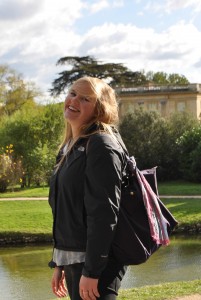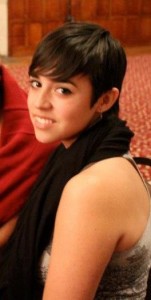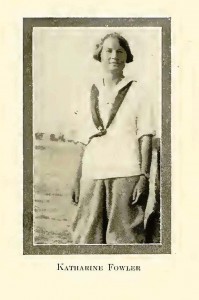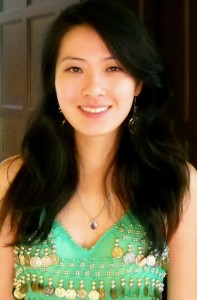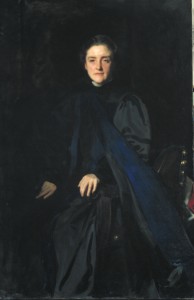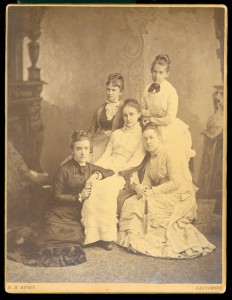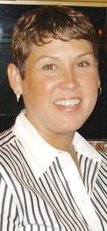As a student worker in Special Collections, I get the opportunity to do a lot of interesting research. Presently, I’m working on research that will contribute to an exhibition in 2013, and as part of this I have been reading about different topics from the late 19th century on women and education.
I’ve done some relevant coursework, Professor Elliott Shore’s History of Bryn Mawr being the most relevant, but also a sociology course entitled “Women, the Body, and Society”. But I never really delved as deep into the research as I have for this exhibition. For instance, did you know that many 19th century doctors were convinced that women were incapable of developing their brains and their reproductive organs simultaneously? Perhaps it’s a sort of hold-over from the more medieval concept of balancing humors.
There are two major contemporary texts on the issue that I have been reading side by side: Dr. Edward Hammond Clarke’s Sex in Education; or, A Fair Chance for the Girls, published in 1873 and the provocative reply by Julia Ward Howe entitled Sex and Education, published in 1874. (Special Collection owns copies of both- in excellent condition- but they can also be found online using Google Books and a digital archive of Julia Ward Howe’s works and letters can be found here http://www.juliawardhowe.org/writings.htm)
Dr. Clarke’s book came first and was a leading text used in the fight against women’s higher education. Clarke argues there are physiological reasons that boys and girls cannot be educated together, in the same way: “The physiological motto is: Educate a man for manhood, a woman for womanhood, both for humanity. In this lies the hope of the race.” (Clarke 19) A good portion of the argument revolves around reproduction – if women do not develop their sex organs properly, they cannot continue making babies.
But don’t men have sex organs that need developing too, Dr. Clarke? “The growth of [the uterus and ovaries] occurs during the first few years of a girl’s educational life. No such extraordinary task, calling for such rapid expenditure of force, building up such a delicate and extensive mechanism within the organism, — a house within a house, an engine within an engine, — is imposed upon the male physique at the same epoch.” (Clarke 37-38) The modern day equivalent, I think, would be a mansplaining, backhanded compliment: women are too complicated, too delicate, and we should just let the men take care of difficult matters.
Howe’s book is a rather clever response to the seemingly simple argument posed by Dr. Clarke. For her book, Howe collected the views and opinions of male and female writers, doctors, and academics on the subject of women’s education, reasoning against every one of Clarke’s arguments. Thomas Wentworth Higginson, one of the contributors, systematically criticized Clarke’s lack factual evidence and faulty methodology, calling for “facts as to American-born women of different races” (p. 38), “the comparative physiology of different social positions” (p. 39), “an extensive record of individual instances” (p. 40), and an “account of the physiological benefits of education for women” (p. 41). He, and other authors included in the text, were sure that if studied without bias, no differences across gender lines would arise.
One of the most interesting moments for me in reading this text was Howe’s assessment of social causes for the physiological disorders that Clarke cites. “… By far the most frequent difficulty with our women arises from uterine displacement, and this in turn comes partly from the utter disuse of the muscles which should keep the uterus in place, but which are kept inactive by the corset, weighed upon by the heavy skirt, and drawn upon by the violent and unnatural motion of the dancing at present in vogue.” (Howe 29) She briefly discusses the idea of challenging the norms, but relents: “[the opinion that] ‘we are only women, and it does not matter,’ passes from mother to daughter. A very estimable young lady said to me the other day, in answer to a plea for dress-reform, ‘It is better to look handsome, even if it does shorten life a little.’ …” (Howe 28) I think what shocked me most about this was how little things seem to have changed: I suppose there always has been, and always will be, a desire for everyone (women in particular) to look a certain way as dictated by society, regardless of the health effects.
It has certainly been an interesting endeavor for me to think very critically about the position of women and women’s education, and how it has changed. At the time these texts were written, most women did not have access to higher education, and those who did often were criticized heavily for their pursuits. Now, women comprise the majority of college students, though are still underrepresented in many professional fields and graduate level education. But the feminist argument of the time was to support co-education of men and women to ensure that women received the same quality education that men did.
Yet here I sit: the product of four years of a women’s college, a female-dominated environment, and I don’t feel that I’ve been cheated out of any quality where my education is concerned. Could Clarke have been onto something when he counseled against co-education? In my opinion – Howe, Higginson, and any of the others in Howe’s text would have been more than happy to attend a women’s college as long as the quality of education could be guaranteed to meet the same standards as men’s education, (something of great importance to M. Carey Thomas). And besides, it helps to create a positive learning environment for everyone, regardless of gender, when there’s less mansplaining and more collaboration.
This post was created by Michelle Smith, soon to be a graduate of Bryn Mawr College and one of the students who regularly works in Special Collections.
